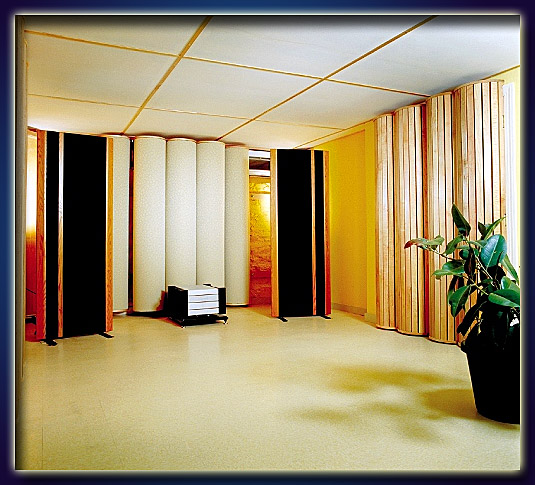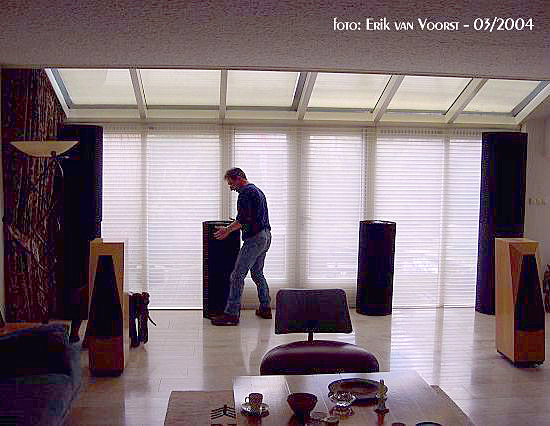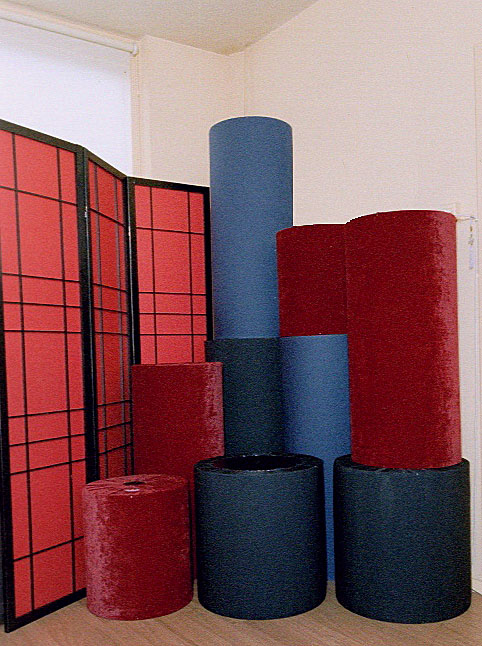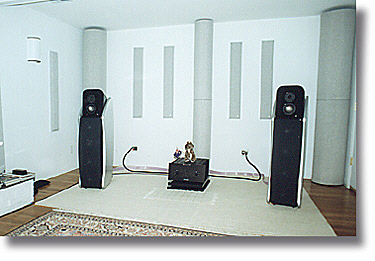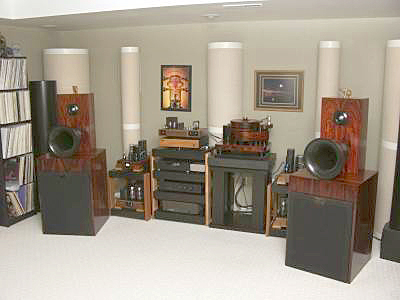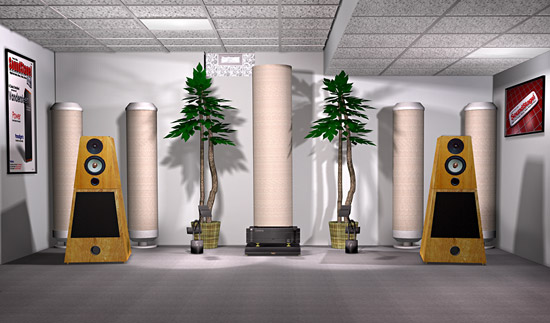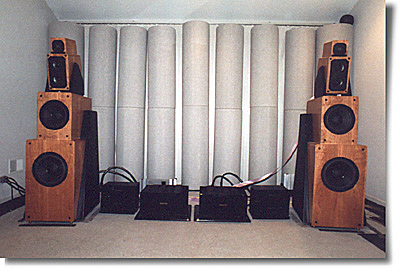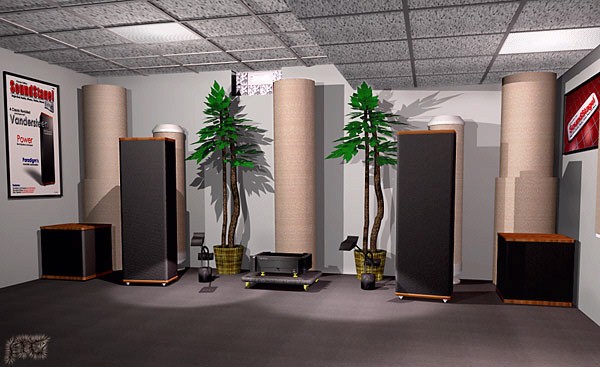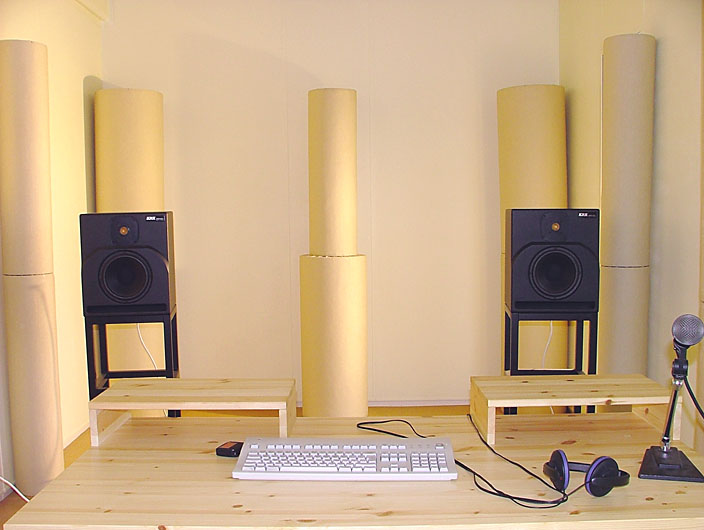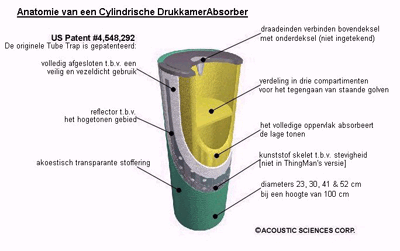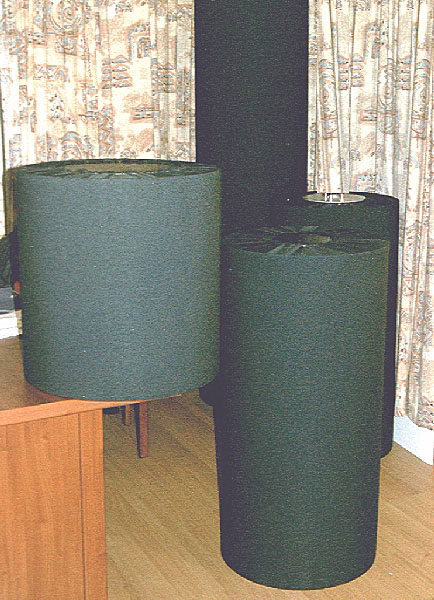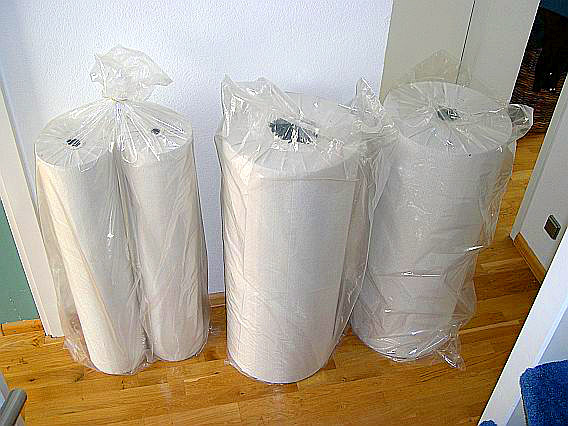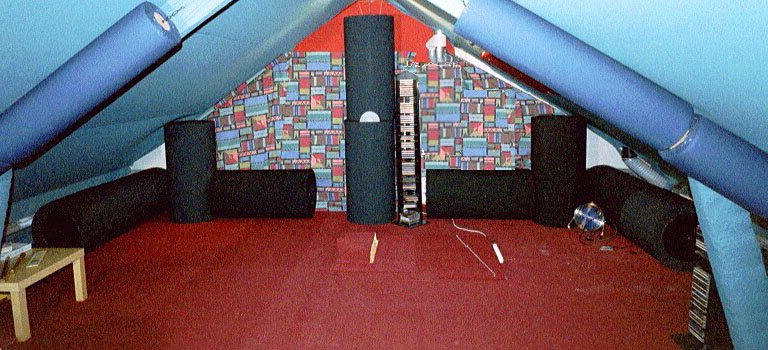More
and Better Bass
Similarly, using the 11 inch diameter Tube Traps to
absorb bass gives you not only better quality bass
but also, surprisingly and again contrary to
conventional wisdom, more impactive and louder bass.
ASC Tube Traps can be used to address and solve a
number of bass problems, and thus accomplish a number
of types of improvements in bass quality and quantity.
The most obvious problem is bass standing waves, the
acoustic resonances of your listening room due to its
dimensions between opposing pairs of surfaces. This
resonant bass ringing of your room sounds just like
the ringing bass boom of some speakers and amplifiers.
Since IAR Journal 3 we've shown how even a single
overshoot in an amplifier's bass transient response
can produce boomy, undefined, heavy, and muddy bass.
Ringing, such as seen in the bass transient response
of some speakers (especially vented bass systems)
sounds even worse. Most listening rooms have
prolonged ringing at their bass resonant frequencies
(and harmonics), so they are the worst offenders of
all, completely negating the work you put into the
rest of your system to get deep, accurate bass. Again,
note that other acoustic absorbent treatments, from
flat panels to stuffed furniture, only absorb upper
frequencies, and do nothing to solve lower frequency
room resonances (indeed, they make the resonances
sound worse, by thrusting the lower frequencies into
greater prominence as they absorb the upper
frequencies only). Some sound studios use very large
moving diaphragm panel absorbers (equivalent to a
flexible wall or floor) to quell the room's acoustic
bass resonances, but these panels are clumsy and
expensive, and they have resonances of their own, so
they solve one problem but contribute others. The 11
inch ASC Tube Traps, placed at the pressure antinodes
of the room's several fundamental resonances plus
their low order harmonics, are a compact, convenient,
relatively attractive and inexpensive alternative.
They are also nonresonant, so they don't add
colorations. And they are effective down into and
through the upper bass (down to about 50 hz). ASC
also makes, to custom order, even larger diameter
Tube Traps, which absorb unwanted resonant energy
down to 10 hz (a 15 inch diameter model is
forthcoming as standard).
The other bass problems are less well known. It is no
longer popular to place your speakers in room corners,
nor even right against the wall, since this excites
the room's resonances worse and also does not give
the best stereo imaging. But nowadays, with your
speakers placed away from the walls, the distance
from the speaker to the nearby wall surfaces corrupts
the bass (and warmth region) in various ways.
Regardless of their mid and high frequency forward
dispersion patterns, virtually all loudspeakers
radiate omnidirectionally in the bass and warmth
regions (dipoles radiate all frequencies to the rear,
but virtuously do not radiate any energy to their
sides). Thus, virtually all speakers radiate full
energy at the nearby wall, floor, and ceiling
surfaces.
For simplicity here, let's consider just the energy
directed toward the wall at the rear of the speaker.
That acoustic energy will reflect from the wall back
toward the listener. So you'll hear a double version
of the music, the original which came directly from
the speaker and the time delayed reflection from the
rear wall. The result is time smeared music (but see
below on LEDE). Furthermore, as this reflected
acoustic energy passes the speaker on the way to the
listener, it combines with whatever new acoustic
information is then coming out of the speaker on its
direct path to the listener. At the frequency where
the distance to the rear wall equals one wavelength,
and st all multiples of that frequency, the acoustic
energy will be reinforced, giving not only tonal
coloration from too much amplitude at those
frequencies, but also a boomy overhang (similar to
resonant ringing) to the bass quality at those
frequencies. Then, at half that fundamental frequency,
farther down into the bass, the distance will be half
a wavelength, and there will be almost complete
acoustic cancellation of your bass by the wall
reflection at that frequency, and all multiples of it.
If you use ASC Tube Traps to absorb all that low
frequency energy when it arrives at the rear wall, it
won't reflect back toward the speaker and listener.
So you won't get those phony boomy peaks at the full
wavelength frequencies. And you won't get those
cancellations at the half wavelength frequencies. You'll
get a flatter tonal balance with less coloration, and
better quality transient information in the bass and
warmth regions. Note that the lowest frequency
aberration caused by the rear wall reflection was a
cancellation, not a peak, and that it was at a bass
frequency. Getting rid of this lowest frequency
aberration, by using absorbent Tube Traps, will
therefore increase the amount and impact of bass
energy from your system. Once again, this finding
contradicts the conventional wisdom that absorbent
room treatment soaks up and diminishes the loudness
or power you'll hear from your system st the absorbed
frequencies.
The obvious bass application of bass absorbers may be
to reduce the room's standing wave resonances, a
phenomenon that takes place between pairs of the room's
Surfaces. In this role they improve the quality of
bass transients and reduce the mud factor by
eliminating ringing overhang, while reducing excess
bass amplitude (and reverb decay time) at the room's
resonant frequencies. But in this more subtle
application, the absorber treats a phenomenon that
takes place between a single room surface and the
speaker. And here it serves not only to again improve
the quality of bass transients and lower tonal
colorations, but also to increase the amplitude of
bass, that bass formerly lost to cancellation
interaction between the speaker and a single nearby
surface.
Obviously, you should use bass absorbers on not just
the rear wall, but also the side walls and ceiling
near the speakers. These other single surfaces also
cause bass cancellation at other frequencies, so you'll
hear your system's bass increased to its correct
amplitude at these several frequencies which were
being cancelled.
This single surface cancellation effect, correctable
by ASC Tube Traps, applies not only to speakers. It
also applies to live instruments. Bass viols and 'cellos
have some of their natural warmth and bass cancelled
by interfering reflections from the nearby floor,
with tonal colorations and time smearing caused by
additive reflections at other frequencies. So ASC
Tube Traps, lying horizontally on the floor, could be
used to make live instruments sound more natural. And
indeed, the world premiere concert using ASC Tube
Traps has already taken place -- and everyone
marveled at the more powerful bass they heard from
live instruments.
Single surface interference problems also occur
between you the listener and the surfaces near you,
for the same reasons and in the same ways. So for
better bass you should also treat the surfaces around
your listening position.
So far, we've spoken of this single surface
interference only in terms of complete cancellation
and reinforcement (which effectively double the
amplitude). But in between these extremes, and at all
the frequencies lying between those frequencies where
these extreme phenomena occur, there is still
unwanted interference from single surface reflections,
and there is still some corruption of what should be
the correct amplitude level at all these other
frequencies, either a gain or loss. You can think of
this interference, between direct and reflected
acoustic energy, as two sine waves combining, not at
their maxima or minima (giving complete cancellation
or reinforcement), but rather at some other points
during their cycles. Furthermore, as Henning Moller
has pointed out, the resultant of these .two sine
waves combining, at all those frequencies where their
maxima and minima are not synchronized, is a new wave
whose phase is all screwed up relative to what it
should be, and relative to either the direct or
reflected signal. Here you are paying attention to
your system's absolute phase polarity, having your
subwoofer in the correct polarity, and even phase
aligning your subwoofer (which we found to be audibly
important in testing the Spica subwoofer) --but then
the reflections from nearby surfaces totally screw up
the phase of your bass. Absorbing the bass energy at
the surfaces with ASC Tube Traps cures all these
problems too, and Henning has found that the
improvement in bass phase response is audible. This
corroborates the work done recently by KEF, in
improving the bass phase response of speakers, which
also found that correct bass phase response is
audibly important (see our report in Hotline 37).
TOP
